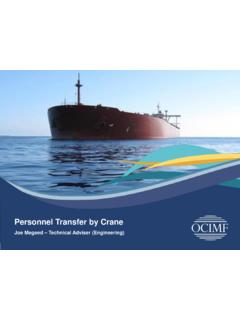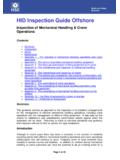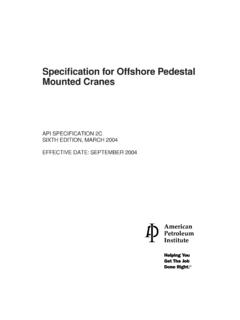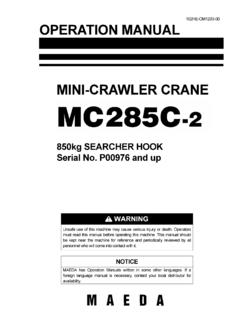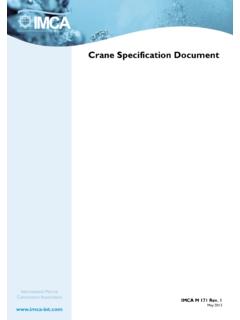Transcription of Guidance on the transfer of personnel to and from …
1 Guidance on the transfer of personnel to and from Offshore Vessels IMCA SEL 025, IMCA M 202 March 2010 International MarineContractors AB The International Marine Contractors Association (IMCA) is the international trade association representing offshore, marine and underwater engineering companies. IMCA promotes improvements in quality, health, safety, environmental and technical standards through the publication of information notes, codes of practice and by other appropriate means. Members are self-regulating through the adoption of IMCA guidelines as appropriate.
2 They commit to act as responsible members by following relevant guidelines and being willing to be audited against compliance with them by their clients. There are two core activities that relate to all members: Competence & Training Safety, Environment & Legislation The Association is organised through four distinct divisions, each covering a specific area of members interests: Diving, Marine, Offshore Survey, Remote Systems & ROV. There are also five regional sections which facilitate work on issues affecting members in their local geographic area Asia-Pacific, Central & North America, Europe & Africa, Middle East & India and South America.
3 IMCA SEL 025, IMCA M 202 This Guidance was prepared under the direction of the IMCA Safety, Environment & Legislation (SEL) Core Committee. The information contained herein is given for Guidance only and endeavours to reflect best industry practice. For the avoidance of doubt no legal liability shall attach to any Guidance and/or recommendation and/or statement herein contained. 20 10 IMCA International Marine Contractors Association Guidance on the transfer of personnel to and from Offshore Vessels IMCA SEL 025, IMCA M 202 March 2010 1 Glossary of Terms .. 1 2 Executive Summary .. 2 3 General Issues.
4 3 Risk Assessment .. 3 Training and Competence .. 4 Responsibility .. 4 Communications .. 4 4 Types of personnel transfer .. 5 Vessel to Vessel transfer Using a Small Boat .. 5 Equipment .. 5 Crew Boat transfer .. 5 Embarkation/Disembarkation .. 6 Equipment .. 7 Passenger Accommodation and Safety Equipment .. 7 personnel transfer Basket .. 7 Equipment .. 9 Gangway, Bridge and Accommodation Ladder transfer .. 9 10 Hydraulic Gangways .. 10 Pilot transfer .. 10 5 Further Information .. 12 Figures Figure 1 personnel transfer from a crew boat to a larger vessel using a surfer (photo: Saipem).. 6 Figure 2 personnel transfer using a Billy Pugh (photo: Saipem).
5 8 Figure 3 personnel transfer using an Esvagt device (photo: Saipem) .. 8 Figure 4 personnel transfer using a personnel transfer capsule (photo: Saipem) .. 8 Figure 5 personnel transfer using a purpose-designed hydraulic gangway (photo: Mermaid Offshore) .. 10 Note: Photographs are for illustrative purposes only and may not represent current good practice. IMCA SEL 025, IMCA M 202 1 1 Glossary of Terms A number of specialised terms are used in this document. It is assumed that readers are familiar with most of them. However, a number of them, although in use for many years, could be misunderstood. These terms are defined below to ensure that readers understand what is meant by them in this document.
6 FRB Fast rescue boat ISPS Code International Ship & Port Security Code MODU Mobile offshore drilling unit OIM Offshore installation manager SIMOPS Simultaneous operations SOLAS Safety of Life at Sea Crew boat A vessel of less than 500 gross tonnage, generally used for personnel transfer Small boat A craft that is likely to be stowed on a larger vessel, platform or other offshore structure, usually less than 10m in length. Such craft are likely to be launched and recovered using a davit arrangement Surfer This is typically a crew boat fitted with a purpose built arrangement intended to dock with a suitable fitting on the receiving vessel or installation to aid the safe transfer of personnel 2 IMCA SEL 025, IMCA M 202 2 Executive Summary One of the activities specific to offshore operations is the transfer of personnel between vessels and other offshore structures.
7 Such transfers can include movements of personnel at crew change and shift change from vessel to vessel and also between vessels, offshore structures, barges and crew boats as well as to and from the quayside. This document is intended to provide Guidance for the offshore industry on the safe transfer of personnel at sea. It covers risk assessment, training and competence, responsibility, equipment and communications, and focuses on the main methods of personnel transfer between vessels, offshore structures and the quayside. The primary methods of personnel transfer covered are: Small boat or launch; Larger crew boat or support vessel; personnel transfer basket; Gangways, bridge or accommodation ladders, including motion-compensated hydraulic gangways; Mating surfer structures allowing personnel to transfer safely.
8 For each case, the document covers the main safety issues and gives some information about the specialist equipment that may be involved, such as surfers , as well as special duties or responsibilities of personnel involved, particularly with regard to communications. personnel transfer by helicopter is a separate subject adequately addressed elsewhere and is not covered in this document. IMCA SEL 025, IMCA M 202 3 3 General Issues personnel being transferred should be briefed prior to the transfer and should be familiar with the method of transfer and the equipment being used. personnel involved in a transfer should be physically able to make the transfer , should understand the intended activity and should have agreed to the transfer method being proposed.
9 Where available personal protective equipment (PPE), including a safety helmet, should be worn. personnel joining or leaving a vessel or offshore structure at crew change may not be wearing appropriate PPE such as safety boots, for example. A risk assessment, including these factors and consideration of the length of time personnel have been travelling and their tiredness, should be conducted prior to the transfer . Where appropriate, an approved inflatable life jacket, fitted with light and whistle, should also be worn. In selecting the type of life jacket to be used the possibility of a fall from height should be taken into account.
10 In medical evacuation cases, specific risk assessments and methods would be required. All luggage should be transferred as a separate operation. personnel should not carry luggage during the transfer . Risk Assessment All personnel transfers at sea, irrespective of the method, should be treated as a stand-alone operation, and a formal risk assessment should be carried out beforehand. Should conditions change at the time of the transfer , the impact of these changes should be considered and appropriate management of change procedures implemented as necessary. If there are any concerns regarding the safety of the operation, the transfer should be prevented.

